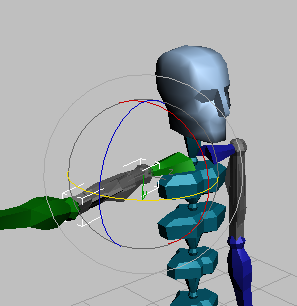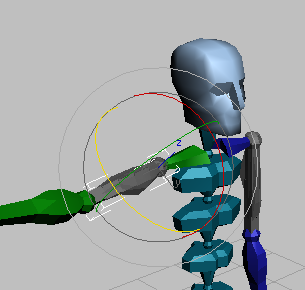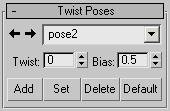The toolset of this rollout lets you create and edit twist poses for a biped's limbs.
You can either use the rollout's preset poses (which you can modify and rename), or create your own. When you add a new pose, you establish a reference between the selected's limb relative orientation and the rollout's Twist value of 0 (which means no twist). When more than one reference pose are set for a rotated limb, the limb's twisting is calculated based on the nearest pose.
The Twist Poses rollout tools only affect limbs with three degrees of freedom (DOF), such as upper arms and thighs, because you can control their twist links by rotating them. Two-DOF limbs (forearms and calves, for instance) differ due to the fact that you can only control their twist links if you rotate their child limb.

The upper arm can twist itself while the forearm needs the wrist to twist it.
Example: To Add and Edit Twist Poses:
This procedure takes into account the concept of adding twist links to biped limbs and concentrates on using the tools from the Twist Poses rollout to set up basic poses.
 (Figure Mode), and then expand the Twist Poses rollout.
(Figure Mode), and then expand the Twist Poses rollout.
 Select the right upper arm.
Select the right upper arm.
The rollout controls are enabled because you selected a three-DOF limb.
 (Previous Key) and
(Previous Key) and  (Next Key) to cycle through the different pose presets.
(Next Key) to cycle through the different pose presets.
The biped's arm extends upwards and shows some twisting.

This assigns the Twist value of 0 to the upper arm's twist links.
 Rotate the upper arm locally around its Y axis so it extends to the side.
Rotate the upper arm locally around its Y axis so it extends to the side.
This new pose resets the current Twist value of the twist links.
 Rotate the upper arm locally around its X axis.
Rotate the upper arm locally around its X axis.
The twisting in the upper arm is calculated based on the limb's proximity to the saved poses.

Rotate the upper arm to verify the twist links.


 Previous/Next Key
Previous/Next KeySets the distribution of rotation along the twist links. A setting of 1.0 concentrates the twist towards the top link while a setting of 0.0 instead concentrates it towards the bottom link. The default setting is 0.5, distributing the rotation evenly throughout the links. The twist links from the opposite side are so affected.